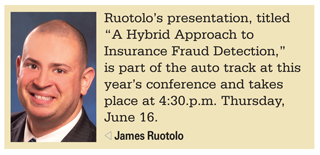 Minimizing fraud losses can be a daunting task, but with the right strategy, your organization can nab more fraudsters than you might think. At America's Claims Event (ACE) this month, James Ruotolo, principal for insurance fraud at the SAS Institute, will present a hybrid approach to insurance fraud detection. Attendees at this Thursday afternoon session will learn to combine detection techniques, helping to minimize a false-positive rate while maximizing their available investigative resources.
Minimizing fraud losses can be a daunting task, but with the right strategy, your organization can nab more fraudsters than you might think. At America's Claims Event (ACE) this month, James Ruotolo, principal for insurance fraud at the SAS Institute, will present a hybrid approach to insurance fraud detection. Attendees at this Thursday afternoon session will learn to combine detection techniques, helping to minimize a false-positive rate while maximizing their available investigative resources.“Individual detection methods each have value but tend to produce a high false-positive rate on their own,” Ruotolo explained. “Investigating false positives is a waste of limited SIU capacity.”
Ruotolo says that the biggest challenge today for special investigation units (SIUs) is the need for a shift in thinking and methodology to address organized fraud exposure. In this interactive session, Ruotolo will discuss the pros and cons of various detection methods, how a hybrid approach can combine the best features of each detection method, and how to overcome the hurdles to implementing a fraud detection technology program.
“For years, the industry has relied almost exclusively on business rules or 'red flags' to detect suspicious claims,” Ruotolo said. “Furthermore, SIUs have been structured to handle single claim investigations. Detection and investigation of organized fraud ring activity, such as staged accident fraud, requires more advanced technology to handle the large amount of data involved.” One technique Ruotolo will discuss is breaking down silos via advanced data integration. Silos can exist in all parts of an organization and can create divisions within an SIU.
Recommended For You
Want to continue reading?
Become a Free PropertyCasualty360 Digital Reader
Your access to unlimited PropertyCasualty360 content isn’t changing.
Once you are an ALM digital member, you’ll receive:
- Breaking insurance news and analysis, on-site and via our newsletters and custom alerts
- Weekly Insurance Speak podcast featuring exclusive interviews with industry leaders
- Educational webcasts, white papers, and ebooks from industry thought leaders
- Critical converage of the employee benefits and financial advisory markets on our other ALM sites, BenefitsPRO and ThinkAdvisor
Already have an account? Sign In Now
© 2025 ALM Global, LLC, All Rights Reserved. Request academic re-use from www.copyright.com. All other uses, submit a request to [email protected]. For more information visit Asset & Logo Licensing.








